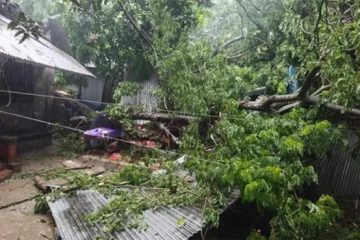Govt sits idle as Shankharibazar houses get more vulnerable
Pinaki Roy

Monday night’s collapse of roof plaster at Shankharibazar is a chilling reminder that run-down buildings in this part of the city could cost lives any time and the government cannot afford delays in dealing with the looming disaster.
Recently, the government has decided to declare Shankharibazar a heritage site following recommendation of an expert committee.
Once a gazette notification is published to that effect, house owners in the area will not be able to destroy the age-old structures to build new ones.
Locals fear the declaration will only make things worse as the department concerned does not have any plans to start conservation immediately due to fund and manpower constraints.
In June 2004, 11 people were killed and many others injured when an old building came crashing down on its occupiers.
Following the cave-in, experts from Dhaka City Corporation (DCC) and Rajdhani Unnayan Kartripakkha (Rajuk) identified 32 houses as highly vulnerable and 91 as risky.
In Monday night’s incident, three people were injured when a large chunk of plaster broke off the roof of Madan Mohan Mandir, one of the oldest ornamented buildings at Shankharibazar.
“We are yet to start preserving the structures listed as heritage sites long before Shankharibazar,” said Abdul Khaleque, director general of the government’s archaeology department.
“No doubt we need to conserve Shankharibazar. But unfortunately we don’t have the funds required to conserve the entire area,” he said adding that a collective community approach would rather help the situation improve.
According to historians, the 300-year-old city quarters were built during the Mughal period and later part of the British rule for the craftsmen who make ‘Shankha’ (bangles made of seashells).
Currently, a few hundred families live at 142 houses lining a 600-foot narrow alley at Shankharibazar.
Over the years, unplanned renovation has diminished the heritage value of the houses that boast a distinct architectural style.
Cultural activists say Shankharibazar warrants immediate conservation. The government must come up with comprehensive plans so that the entire area remains as it is, and the locals too are out of danger.
Meanwhile, the growing value of land at Shankharibazar appears too tempting for the house owners not to make way for high-rises.
Biswajit Dutta Bhulu, caretaker of a temple-cum-house at holding No. 14, one of the biggest structures in the area, plans to build a multi-storey there.
He has already started knocking down the rear portion of the building.
“This property belongs to Lord Krishna. I’m only a caretaker. I cannot sell it but I can surely develop it,” said Biswajit.
Replying to a query, he said he does not want his temple to be part of any heritage site, and if necessary, he is ready to go to the court.
Besides being used as a temple, the building houses many families.
“The structure is so old that it may collapse any time and cause a tragedy like that in 2004,” he said.
Experts think the government’s decision to declare Shankharibazar a heritage site is in fact the beginning of the conservation process. Now the owners should not demolish the houses; instead they should help the authorities preserve those.
Architect Taimur Alam, who has been working on the ancient site, said, “Some owners want to knock down the old structures. If they do so, it will be a huge blow to the conservation move.”
Shafiqul Alam, former director general of the archaeology department, said the French government had once proposed to help conserve the houses and the community at Shankharibazar. But they backed away fearing legal tangles stemming from multi-ownership of the structures.
“Most of the houses have multiple owners. While some are willing to let their houses preserved properly, the others appear bitterly opposed to the idea. So ultimately we will have to face legal battles if we are to go ahead with the conservation plans,” Shafiqul added.
Some houses are owned by as many as 50 people.
Courtesy: thedailystar.net




















